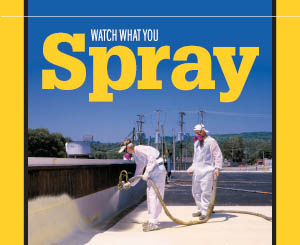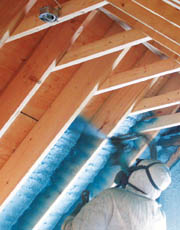

Owners and developers, particularly in the owner-occupied and public sectors, are demanding higher performance buildings; just look at all the new construction guidelines, such as Building for Environmental and Economic Sustainability and Leadership in Energy and Environmental Design, not to mention stricter state building and energy codes. Among other things, higher performance can mean greater durability, better energy efficiency, and improved occupant health, safety and comfort.
The building science community has known for some time that improving the quality of the building envelope is one of the best ways of improving specific elements of overall building performance. An estimated 54 percent of energy consumption in the United States is directly/indirectly related to buildings and their construction.1 The U.S. Department of Energy reports 40 percent of the energy cost of heating and cooling a building is wasted by uncontrolled air leakage through the building envelope. This uncontrolled leakage can also contribute to premature building deterioration, condensation, spalling, ice damming, poor indoor air quality and mold growth.
Engineered to optimize site-specific performance
The first documented application of SPF in the United States occurred in 1958. In recent years, SPF has evolved into one of the fastest growing polymers in construction. It is a two-component product engineered on the molecular level for a specific purpose, including roofing insulation, cathedral ceilings, attics and air seals, wall insulation and air barrier systems, below-grade foundation insulation and below slab-on-grade.Three types of SPF are used within the engineered building envelope:
• Medium-density for strength, and high moisture resistance and insulating values
• Low-density for lower insulating value, but a modest degree of sound control
• Sealant foams used to caulk around windows, doors, sill plates, and other locations
R-values of SPF used in air barrier, insulation, and roofing applications typically range between 6.0 and 7.5 per inch. Low-density, open-celled SPF typically has a stable aged R-value ranging from 3.4 to 3.6 per inch.
Closed-cell SPF is sprayed-in-place, making it seamless and 100-percent fully adhered where applied. It requires no fasteners or adhesives, and will not shrink or sag over time, making it ideal for use in vertical wall, cathedral ceiling and below-grade exterior applications. It conforms to irregular shapes and expands to fill cracks, gaps, holes, and seams for monolithic air impermeability and insulation performance.
SPF air barrier systems meet the requirements for primary air barrier materials under ASTM E 2178-01. SPF wall assemblies have also been tested in accordance with ASTM E 283 ("Standard Test Method for Determining the Rate of Air Leakage Through Exterior Windows, Curtain Walls, and Doors Under Specified Pressure Differences Across the Specimen"). The first assembly consisted of CMU blocks with 0.375-in. mortar joints and a one-inch thickness of SPF. The second assembly consisted of exterior drywall sprayed with a one-inch thickness of SPF. ASTM E 283 allows an infiltration rate of 0.06 cfm/ft2 at a pressure differential of 1.57 lb/ft2 (during the test procedure, no leakage was detected at 1.57 lb/ft2, so the pressure was increased to 6.24 lb/ft2). 2
Safety-SPF can help prevent mold growth by eliminating condensing surfaces and stopping the migration of moisture-laden air through the building structure.
SPF has been tested and approved for use in residential applications and is approved by the Air Barrier Association of America for meeting State Energy Codes.3,4 It emits no volatile organic compounds during installation or during occupancy.5 SPF systems using zero ozone-depleting blowing agents are available and approved for use by the U.S. Environmental Protection Agency's Significant New Alternatives Policy program.
Durability-SPF has a 40-year track record of proven in-field performance. In the mid-90s, NRCA's National Roofing Foundation commissioned Structural Research Inc., of Middleton, Wis., to perform an independent field and laboratory assessment of SPF roof systems to establish and verify existing performance attributes.6
It was found that average compressive strength and core density for all samples were well above modern specifications, while average moisture content was negligible, at 1.02 percent by weight.
Wind uplift-SPF offers a very high wind uplift resistance rating. Mason Knowles, executive director of the Spray Polyurethane Foam Alliance, reports SPF's wind uplift resistance exceeded the capacity of Universal Laboratory's equipment during laboratory testing. UL also observed SPF applied over built-up roofs and metal increased their wind uplift resistance. Knowles says FM Global's testing showed similar results over concrete, metal and wood.
A post-Hurricane Andrew investigation by Thomas Smith also found that when debris punctured the SPF foam straight down to the metal deck, the roof did not leak, and could actually remain unrepaired indefinitely without developing leakage problems.
SPF air barriers can add structural strength to buildings. Testing conducted by the National Association of Home Builders Research Center showed that, "During a design racking event, such as a hurricane, there would be less permanent deformation of wall elements and possibly less damage to a structure that was braced with SPF-filled walls."7
Energy efficiency-Texas A&M University studied the energy efficiency performance of 27 different buildings on the campus that had received an SPF roof between 1980 and 1984. The results show the university was able to recover the complete cost of the roofs through energy savings realized over an average of 4.5 years.8
Stack effect-Wind pressurizes the windward side of the building and depressurizes the other sides and roof, accounting for up to 25 percent of total air leakage. The remaining 75 percent of air leakage is induced by stack effect and fan pressurization.
One- and two-component air sealing polyurethane foams are used to seal gaps, cracks, and holes, and provide the all-important air barrier continuity between the elements of the building envelope.
Proof of the connection between a retrofitted building envelope and reduced HVAC operating costs can be found in many documented projects. In the '70s, 17 percent average electricity savings resulted from simple air sealing of roof/wall joints in single-story public schools in Toronto. Perimeter air sealing of high-rise apartment buildings in Ottawa, Canada, and Toronto showed an average of more than 10-percent reduction in electrical demand, and about nine percent reduction in electricity consumption.
The Air Barrier Association of America approves the use of SPF engineered building envelope systems to meet the 29 state commercial energy codes that meet or exceed ASHRAE 90.1-89, "Energy Standard for Buildings Except Low-Rise Residential Buildings."
Looking Forward
To gain a real understanding of the end-use performance, the industry is moving toward evaluating the thermal performance of an entire wall instead of just the R-values of individual materials. Joint work is being planned by the NAHB Research Council and the American Plastics Council to evaluate different wall systems with the goal of developing guidelines for an accepted energy performance rating for entire wall systems, while Oak Ridge National Laboratory and DoE continue research into the contribution of the building envelope to the safety, durability and energy efficiency of the structure.Footnotes:
1 According to a 1998 report by Godfried Augenbroe and Annie R. Pearce of Georgia Institute of Technology.2 The Use of Spray Polyurethane Foam in Masonry Cavity Wall Construction, Morrison, Roger V. RCI Interface, April 2004
3 Canadian Construction Materials Centre, Evaluation Report 12932-R, National Research Council of Canada.
4 Air Barrier Association of America (www.airbarrier.org).
5 Air Barrier Association of America (www.airbarrier.org)
6 Dupuis, R.M., "Field and Laboratory Assessment of SPF Roof Systems," Proceedings of the 4th International Symposium on Roofing Technology, 1996.
7 National Association of Homebuilders Research Center. "SPF Wall Panel Performance Testing, 1992 and 1996." Berkeley, Calif.
8 1985 study by Gerald Scott, PE, of Texas A&M University showed significant energy savings on 27 different campus buildings re-roofed with SPF between 1980 and 1984. The complete cost of re-roofing was covered by energy cost savings within 4.5 years.

Report Abusive Comment